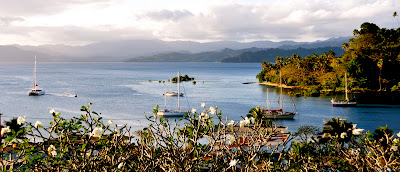Note: This is our first attempt at taking videos, and the quality of the footage and editing is not what we had hoped. Please be patient with us as we get up and running.
(The following text is from Reid Coen's original handout at the Travelogue. We have inserted hyperlinks about specific sites to provide you with more information.)
"
The island paradise of Bali has long been the traveler's jewel of Indonesia. Blessed with great natural beauty, a rich cultural heritage, welcoming locals, and low prices, it is a perfect Southeast Asian destination. Travelers enjoy volcanic peaks, photogenic rice terraces, dramatic waterfalls, and some of the world's best beaches on an easily traversed island of only 5,600 square miles. The cultural life is colorful, rich, accessible, and engaging and includes dance, music, and theater. The island is dotted with beautiful temples and Balinese arts and crafts make it a shopping paradise. A traditional Hindu-Animist culture means visitors are safe and treated as honored guests. Finally, and perhaps best, Bali is an incredible travel bargain for Americans. By adding a quick foray to neighboring Java and its cultural capital, Jogjakarta, one can also enjoy the dual World Heritage sites of
Borobudur and
Prambanan.
"
Southern Bali
Kuta, Legian, Seminyak - Bali's biggest "scene"; the hub of commercial resort tourism; easy access to airport; great beach, great surfing, great shopping, accommodations for every budget, nightlife, spas, and entertainment. Tuban is slightly milder; one great spot:
Waterbom Park.
 |
Dancer
Ubud, Bali |
"
Nusa Dua - International resort chain HQ
"
Sanur - a quieter alternative; lovely beach with promenade; access to Denpassar accomodations and restaurants for every budget
"Sights/Activities:
Ulu Watu - one of Bali's most dramatically situated temples; stunning cliffs, lovely sunsets; Kecak/Fire dance nightly; nearby beaches for serious surfers, sunset seafood barbeque at
Jimbaran Beach
 |
| Pura Goa Lawah Temple |
"
East Bali
Southeast coast - beaches and temples: Goa Lawah (Bat Cave Temple); Padang Bai (boats to Nusa Penida and Lombok);
Candi Dasa -- quieter beach resort area; Tenganan - traditional Bali Aga village and craft center; Water Palaces of Ujung (abandoned) and
Tirtagangga (still operational); Ujung to Kusambi coast road
Amed - quiet, undeveloped coastline; good snorkeling and diving; pebble beaches
Gunung Agung - Bali's highest, most holy peak -- rice terraces (Sideman Rd.);
Besakih - the mother temple, Bangli temples
 |
Rice terraces
|
"
West Bali
Tanah Lot - Bali's most famous temple; on island off southwest coast; sunset institution; sunrise without the crowds (Rambut Siwi)
Menjangan island snorkeling/diving; Lovina Beach -- quieter vibe; dolphins
 |
| Tanah Lot, southwest coast |
"
Interior Bali
Ubud - Bali's cultural capital: performances (Barong, Legong, Kecak, Ramayana, puppet theater, +), shopping (clothing, textiles, craft villages north and south), art (Puri Lukisan, Neka Gallery), dining, courses (cooking, meditation, dance, music, arts/crafts); trekking; rafting; cycling; bird watching
Sightseeing near Ubud: Goa Gajah (Elephant Temple); Yeh Pulu; Gunung Kawi;
Tirta Empul water temple; Klungkung
Special Events: cremations and temple festivals
"
Mt. Batur - volcanic mountain with steaming lava dome, verdant caldera with lake, caldera-hanging temples, spectacular views, magical sunset/sunrises
 |
| Gunung Batur, Bali |
"Muduk/Bratan area - picturesque island temple Pura Bratan; Bali's best Botanical garden (Treetop Adventures); Munduk trekking -- waterfalls, lakes, mountains
 |
Borobudur - 8th Century Buddhist Temple Complex
World Heritage Site, Java |
"Jogjakarta (Yogyakarta), Java
Easy access - 70 minute flight; <$100;
great tourist infrastructure -- lots of accommodations (all budgets; Prawirotaman neighborhood)
Jogja - Kraton, Taman Sari water palace, bird market, batik demos/shopping, Kota Gede silver, shopping centers; Ramayana Ballet -- Puriwisata or Pramban (summer outside)
Borobudur - truly awe inspiring, 8th century Buddhist stupa "mountain", with Angkor Wat the greatest ancient monument in SE Asia
Prambanan - impressive 9th century Hindu temple site
 |
Prambanan Temple Complex
World Heritage Site, Java |
Reid Coen
Imprint Tours
3033 NW 66th St.
Seattle, WA 98117
206-617-9928
Ballyhoo! Books on Bali
A quick look in our stacks revealed the following guidebooks on Bali and surrounds. You can use any of these titles to continue your research...
Diving Bali: The Underwater Jewel of Southeast Asia by David Pickell & Wally Siagian
Lonely Planet Guide to Bali & Lombok, 12th Edition (Apr 2009)
Lonely Planet Bali Encounter, 2nd Edition (Oct. 2010)
DK Eyewitness Travel: Bali & Lombok (2009)
Eating Smart in Indonesia: How to Decipher the Menu, Know the Market Foods, & Embark on a Tasting Adventure by Joan and David Peterson (1997)


















